The Strategy and Change Interface: An Essay on Implementation
VerifiedAdded on 2023/01/17
|13
|3639
|94
Essay
AI Summary
This essay delves into the dynamic relationship between strategy implementation and organizational change in the modern business environment. It highlights the importance of strategic change for businesses to maintain competitiveness in a globalized market, emphasizing the need for flexibility and productivity. The essay explores different definitions and dimensions of strategy implementation, emphasizing the alignment of organizational resources and skills with environmental opportunities. It discusses the role of strategy in guiding organizational activities and responding to environmental threats, while also acknowledging the challenges in implementation, such as structural changes affecting employee networks. Furthermore, the essay covers emergent strategies, the integration of strategies, and the importance of management information systems and human resources in the implementation process. It also identifies barriers to strategy implementation, including misalignment of goals, short-term versus strategic planning, and mismanagement of information systems. Finally, the essay touches upon organizational change, its relationship with strategy implementation, and the need for companies to adapt to changing conditions in the environment to ensure survival and success.

Student’s Last Name 1
The Strategy and Change Interface
By Student’s Name
Course Name
Professor’s Name
University Name
City, State
Date
The Strategy and Change Interface
By Student’s Name
Course Name
Professor’s Name
University Name
City, State
Date
Secure Best Marks with AI Grader
Need help grading? Try our AI Grader for instant feedback on your assignments.

Student’s Last Name 2
Introduction
The modern business environment is facing serious challenges because of the dynamic
global economy which requires these businesses to have the flexibility and high productivity to
thrive. For organizations to attain the required effectiveness and efficiency, they have to
strategically change their structure. Businesses can achieve this if they retain the best of
traditional structures they embrace new structures which can add value to the business and
leverage human capital. The business environment of today requires businesses and
organizations to go through changes frequently for them to gain a competitive advantage over
their market rivals. Factors such as changing technology and market globalization force
organizations to change their systems for them to survive the competitive market. Sometimes
such changes may be minor such as the installation of software while sometimes a company may
undergo major changes such as restructuring a marketing strategy or company transformation
amidst serious competition.
Strategy implementation is a fundamental tool in management with many dimensional
concepts that have been defined differently with different authors. While different scholars have
defined strategy implementation differently, there is a general agreement amongst most scholars
that it is about matching the resources and skills of an organization with the environmental
opportunities as well as managing risks that it is facing with purposes of accomplishing the goals
of the organization (Morgan, Katsikeas and Vorhies, 2012, pp.271). Strategy implementation
should be geared towards providing guidance as well as directing activities within an
organization. Because strategic decisions affect the manner in which businesses respond to their
environment, it is important for a company to make strategic decisions and focus its strategy to
its environmental function (Salih and Doll, 2013, pp.32). For most organizations, the strategy is
Introduction
The modern business environment is facing serious challenges because of the dynamic
global economy which requires these businesses to have the flexibility and high productivity to
thrive. For organizations to attain the required effectiveness and efficiency, they have to
strategically change their structure. Businesses can achieve this if they retain the best of
traditional structures they embrace new structures which can add value to the business and
leverage human capital. The business environment of today requires businesses and
organizations to go through changes frequently for them to gain a competitive advantage over
their market rivals. Factors such as changing technology and market globalization force
organizations to change their systems for them to survive the competitive market. Sometimes
such changes may be minor such as the installation of software while sometimes a company may
undergo major changes such as restructuring a marketing strategy or company transformation
amidst serious competition.
Strategy implementation is a fundamental tool in management with many dimensional
concepts that have been defined differently with different authors. While different scholars have
defined strategy implementation differently, there is a general agreement amongst most scholars
that it is about matching the resources and skills of an organization with the environmental
opportunities as well as managing risks that it is facing with purposes of accomplishing the goals
of the organization (Morgan, Katsikeas and Vorhies, 2012, pp.271). Strategy implementation
should be geared towards providing guidance as well as directing activities within an
organization. Because strategic decisions affect the manner in which businesses respond to their
environment, it is important for a company to make strategic decisions and focus its strategy to
its environmental function (Salih and Doll, 2013, pp.32). For most organizations, the strategy is
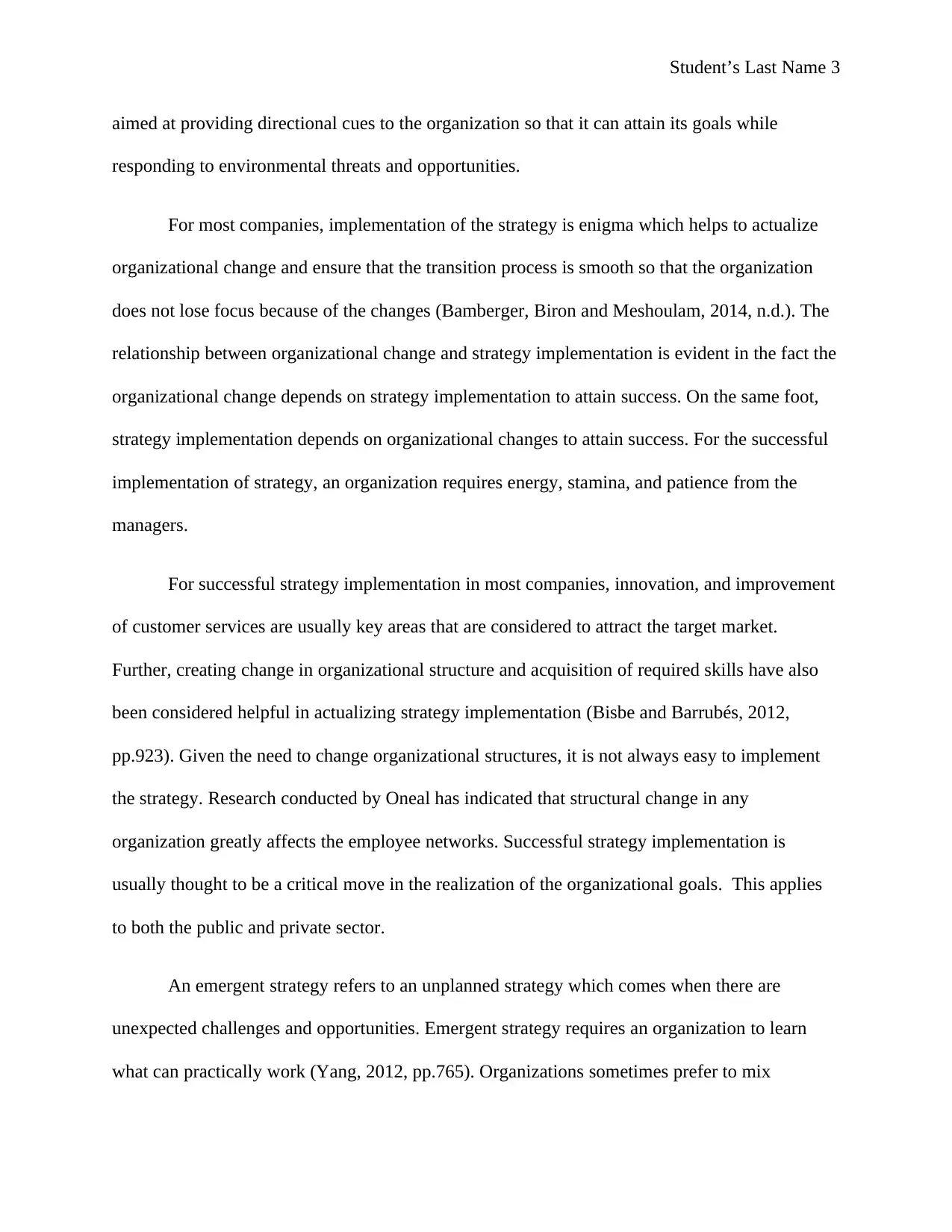
Student’s Last Name 3
aimed at providing directional cues to the organization so that it can attain its goals while
responding to environmental threats and opportunities.
For most companies, implementation of the strategy is enigma which helps to actualize
organizational change and ensure that the transition process is smooth so that the organization
does not lose focus because of the changes (Bamberger, Biron and Meshoulam, 2014, n.d.). The
relationship between organizational change and strategy implementation is evident in the fact the
organizational change depends on strategy implementation to attain success. On the same foot,
strategy implementation depends on organizational changes to attain success. For the successful
implementation of strategy, an organization requires energy, stamina, and patience from the
managers.
For successful strategy implementation in most companies, innovation, and improvement
of customer services are usually key areas that are considered to attract the target market.
Further, creating change in organizational structure and acquisition of required skills have also
been considered helpful in actualizing strategy implementation (Bisbe and Barrubés, 2012,
pp.923). Given the need to change organizational structures, it is not always easy to implement
the strategy. Research conducted by Oneal has indicated that structural change in any
organization greatly affects the employee networks. Successful strategy implementation is
usually thought to be a critical move in the realization of the organizational goals. This applies
to both the public and private sector.
An emergent strategy refers to an unplanned strategy which comes when there are
unexpected challenges and opportunities. Emergent strategy requires an organization to learn
what can practically work (Yang, 2012, pp.765). Organizations sometimes prefer to mix
aimed at providing directional cues to the organization so that it can attain its goals while
responding to environmental threats and opportunities.
For most companies, implementation of the strategy is enigma which helps to actualize
organizational change and ensure that the transition process is smooth so that the organization
does not lose focus because of the changes (Bamberger, Biron and Meshoulam, 2014, n.d.). The
relationship between organizational change and strategy implementation is evident in the fact the
organizational change depends on strategy implementation to attain success. On the same foot,
strategy implementation depends on organizational changes to attain success. For the successful
implementation of strategy, an organization requires energy, stamina, and patience from the
managers.
For successful strategy implementation in most companies, innovation, and improvement
of customer services are usually key areas that are considered to attract the target market.
Further, creating change in organizational structure and acquisition of required skills have also
been considered helpful in actualizing strategy implementation (Bisbe and Barrubés, 2012,
pp.923). Given the need to change organizational structures, it is not always easy to implement
the strategy. Research conducted by Oneal has indicated that structural change in any
organization greatly affects the employee networks. Successful strategy implementation is
usually thought to be a critical move in the realization of the organizational goals. This applies
to both the public and private sector.
An emergent strategy refers to an unplanned strategy which comes when there are
unexpected challenges and opportunities. Emergent strategy requires an organization to learn
what can practically work (Yang, 2012, pp.765). Organizations sometimes prefer to mix
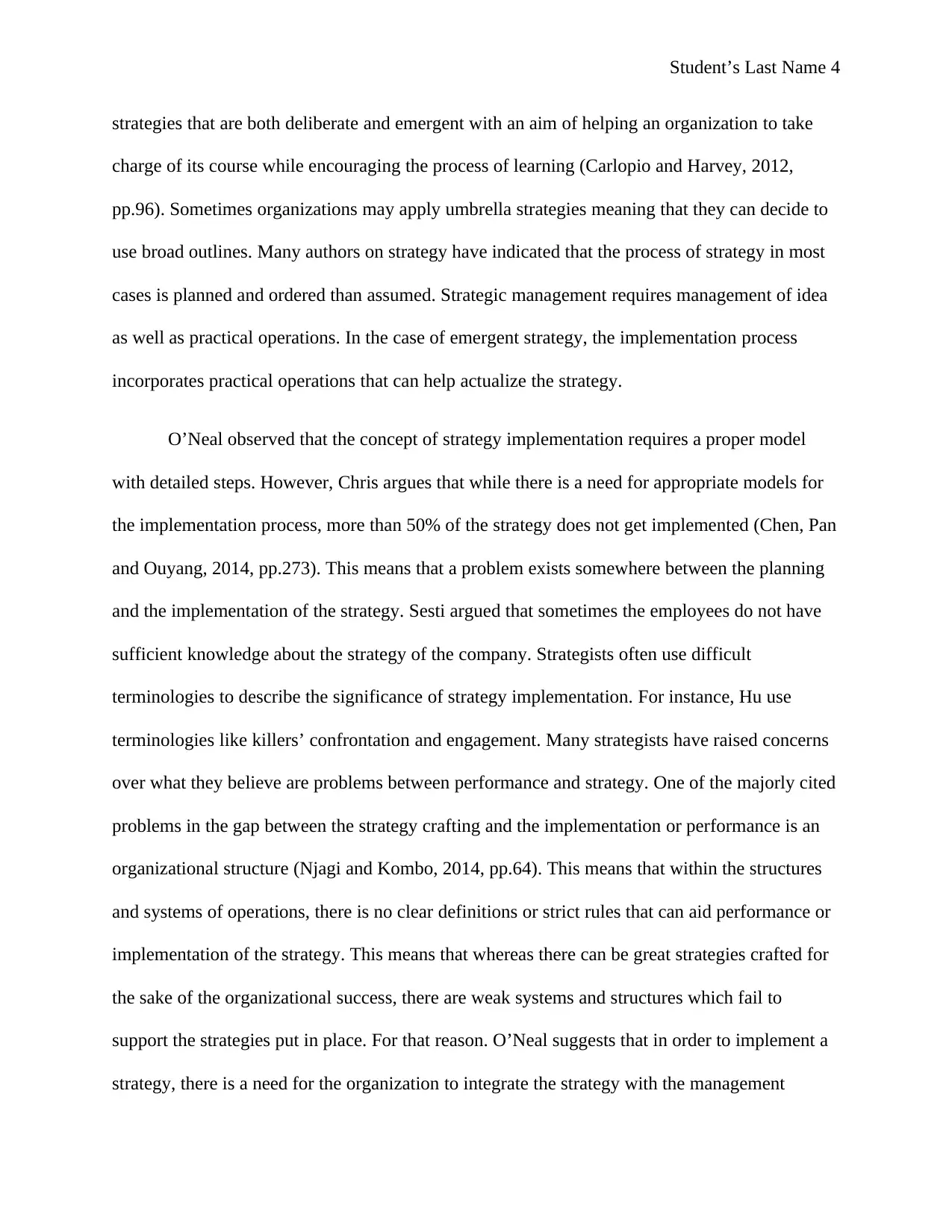
Student’s Last Name 4
strategies that are both deliberate and emergent with an aim of helping an organization to take
charge of its course while encouraging the process of learning (Carlopio and Harvey, 2012,
pp.96). Sometimes organizations may apply umbrella strategies meaning that they can decide to
use broad outlines. Many authors on strategy have indicated that the process of strategy in most
cases is planned and ordered than assumed. Strategic management requires management of idea
as well as practical operations. In the case of emergent strategy, the implementation process
incorporates practical operations that can help actualize the strategy.
O’Neal observed that the concept of strategy implementation requires a proper model
with detailed steps. However, Chris argues that while there is a need for appropriate models for
the implementation process, more than 50% of the strategy does not get implemented (Chen, Pan
and Ouyang, 2014, pp.273). This means that a problem exists somewhere between the planning
and the implementation of the strategy. Sesti argued that sometimes the employees do not have
sufficient knowledge about the strategy of the company. Strategists often use difficult
terminologies to describe the significance of strategy implementation. For instance, Hu use
terminologies like killers’ confrontation and engagement. Many strategists have raised concerns
over what they believe are problems between performance and strategy. One of the majorly cited
problems in the gap between the strategy crafting and the implementation or performance is an
organizational structure (Njagi and Kombo, 2014, pp.64). This means that within the structures
and systems of operations, there is no clear definitions or strict rules that can aid performance or
implementation of the strategy. This means that whereas there can be great strategies crafted for
the sake of the organizational success, there are weak systems and structures which fail to
support the strategies put in place. For that reason. O’Neal suggests that in order to implement a
strategy, there is a need for the organization to integrate the strategy with the management
strategies that are both deliberate and emergent with an aim of helping an organization to take
charge of its course while encouraging the process of learning (Carlopio and Harvey, 2012,
pp.96). Sometimes organizations may apply umbrella strategies meaning that they can decide to
use broad outlines. Many authors on strategy have indicated that the process of strategy in most
cases is planned and ordered than assumed. Strategic management requires management of idea
as well as practical operations. In the case of emergent strategy, the implementation process
incorporates practical operations that can help actualize the strategy.
O’Neal observed that the concept of strategy implementation requires a proper model
with detailed steps. However, Chris argues that while there is a need for appropriate models for
the implementation process, more than 50% of the strategy does not get implemented (Chen, Pan
and Ouyang, 2014, pp.273). This means that a problem exists somewhere between the planning
and the implementation of the strategy. Sesti argued that sometimes the employees do not have
sufficient knowledge about the strategy of the company. Strategists often use difficult
terminologies to describe the significance of strategy implementation. For instance, Hu use
terminologies like killers’ confrontation and engagement. Many strategists have raised concerns
over what they believe are problems between performance and strategy. One of the majorly cited
problems in the gap between the strategy crafting and the implementation or performance is an
organizational structure (Njagi and Kombo, 2014, pp.64). This means that within the structures
and systems of operations, there is no clear definitions or strict rules that can aid performance or
implementation of the strategy. This means that whereas there can be great strategies crafted for
the sake of the organizational success, there are weak systems and structures which fail to
support the strategies put in place. For that reason. O’Neal suggests that in order to implement a
strategy, there is a need for the organization to integrate the strategy with the management
Secure Best Marks with AI Grader
Need help grading? Try our AI Grader for instant feedback on your assignments.
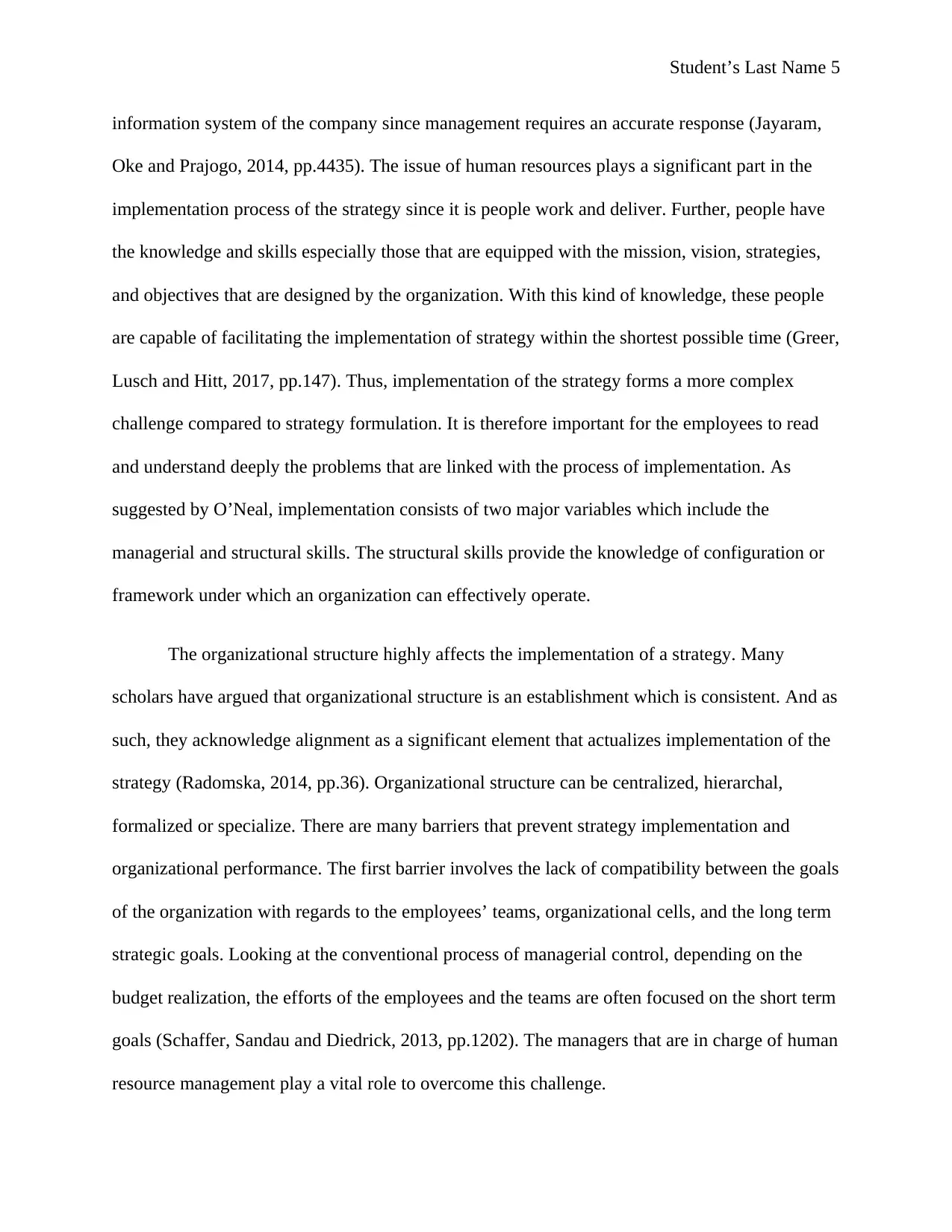
Student’s Last Name 5
information system of the company since management requires an accurate response (Jayaram,
Oke and Prajogo, 2014, pp.4435). The issue of human resources plays a significant part in the
implementation process of the strategy since it is people work and deliver. Further, people have
the knowledge and skills especially those that are equipped with the mission, vision, strategies,
and objectives that are designed by the organization. With this kind of knowledge, these people
are capable of facilitating the implementation of strategy within the shortest possible time (Greer,
Lusch and Hitt, 2017, pp.147). Thus, implementation of the strategy forms a more complex
challenge compared to strategy formulation. It is therefore important for the employees to read
and understand deeply the problems that are linked with the process of implementation. As
suggested by O’Neal, implementation consists of two major variables which include the
managerial and structural skills. The structural skills provide the knowledge of configuration or
framework under which an organization can effectively operate.
The organizational structure highly affects the implementation of a strategy. Many
scholars have argued that organizational structure is an establishment which is consistent. And as
such, they acknowledge alignment as a significant element that actualizes implementation of the
strategy (Radomska, 2014, pp.36). Organizational structure can be centralized, hierarchal,
formalized or specialize. There are many barriers that prevent strategy implementation and
organizational performance. The first barrier involves the lack of compatibility between the goals
of the organization with regards to the employees’ teams, organizational cells, and the long term
strategic goals. Looking at the conventional process of managerial control, depending on the
budget realization, the efforts of the employees and the teams are often focused on the short term
goals (Schaffer, Sandau and Diedrick, 2013, pp.1202). The managers that are in charge of human
resource management play a vital role to overcome this challenge.
information system of the company since management requires an accurate response (Jayaram,
Oke and Prajogo, 2014, pp.4435). The issue of human resources plays a significant part in the
implementation process of the strategy since it is people work and deliver. Further, people have
the knowledge and skills especially those that are equipped with the mission, vision, strategies,
and objectives that are designed by the organization. With this kind of knowledge, these people
are capable of facilitating the implementation of strategy within the shortest possible time (Greer,
Lusch and Hitt, 2017, pp.147). Thus, implementation of the strategy forms a more complex
challenge compared to strategy formulation. It is therefore important for the employees to read
and understand deeply the problems that are linked with the process of implementation. As
suggested by O’Neal, implementation consists of two major variables which include the
managerial and structural skills. The structural skills provide the knowledge of configuration or
framework under which an organization can effectively operate.
The organizational structure highly affects the implementation of a strategy. Many
scholars have argued that organizational structure is an establishment which is consistent. And as
such, they acknowledge alignment as a significant element that actualizes implementation of the
strategy (Radomska, 2014, pp.36). Organizational structure can be centralized, hierarchal,
formalized or specialize. There are many barriers that prevent strategy implementation and
organizational performance. The first barrier involves the lack of compatibility between the goals
of the organization with regards to the employees’ teams, organizational cells, and the long term
strategic goals. Looking at the conventional process of managerial control, depending on the
budget realization, the efforts of the employees and the teams are often focused on the short term
goals (Schaffer, Sandau and Diedrick, 2013, pp.1202). The managers that are in charge of human
resource management play a vital role to overcome this challenge.

Student’s Last Name 6
Another challenge that prevents the implementation of the strategy is associated with the
separation of short term planning and strategic planning. Short term planning can be said to
depend on budgeting. As a result, quarterly and monthly reports concentrate on the explanation
and the interpretation of the reasons that deviates from budget instead of the examination of the
level of implementation of the strategy (Borges, et al., 2016, pp.877). One good example of such
an approach can include the determination of organizational budget that deal with advertising
operations for the sake of increasing sales and improve the brand image for the organization. It
appears normal that some managers can direct their activities and financial resources of the
employees to improve the organizational effectiveness at the expense of long term activities that
purpose to create a positive image for the organization (Lindstedt, 2015, pp.98). Another
challenge that prevents strategy implementation involves mismanagement of the information
systems within an organization and in particular the mismanagement of feedback at the strategic
level. When there is no return of information, managers tend to have very little knowledge about
the operation progress in the strategy implementation.
Change in the organizational structure and other external conditions forces an
organization to implement strategies that will see successful transitions. An organization may,
however, cannot make the changes without having clear information about the effects of the
implemented strategy (Mirabeau and Maguire, 2014, pp.1213). If managers of specific
departments are only subordinate to the expectations of the leaders, they tend to concentrate on
the evaluation and the analysis of the operational goals instead of the strategic goals. The needs
that relate to the rate of strategic implementation, time and way come from the character of the
chosen strategy. This means that the process of implementation action should be incorporated
with the organizational objectives and goals as well as the responsibility that is defined in the
Another challenge that prevents the implementation of the strategy is associated with the
separation of short term planning and strategic planning. Short term planning can be said to
depend on budgeting. As a result, quarterly and monthly reports concentrate on the explanation
and the interpretation of the reasons that deviates from budget instead of the examination of the
level of implementation of the strategy (Borges, et al., 2016, pp.877). One good example of such
an approach can include the determination of organizational budget that deal with advertising
operations for the sake of increasing sales and improve the brand image for the organization. It
appears normal that some managers can direct their activities and financial resources of the
employees to improve the organizational effectiveness at the expense of long term activities that
purpose to create a positive image for the organization (Lindstedt, 2015, pp.98). Another
challenge that prevents strategy implementation involves mismanagement of the information
systems within an organization and in particular the mismanagement of feedback at the strategic
level. When there is no return of information, managers tend to have very little knowledge about
the operation progress in the strategy implementation.
Change in the organizational structure and other external conditions forces an
organization to implement strategies that will see successful transitions. An organization may,
however, cannot make the changes without having clear information about the effects of the
implemented strategy (Mirabeau and Maguire, 2014, pp.1213). If managers of specific
departments are only subordinate to the expectations of the leaders, they tend to concentrate on
the evaluation and the analysis of the operational goals instead of the strategic goals. The needs
that relate to the rate of strategic implementation, time and way come from the character of the
chosen strategy. This means that the process of implementation action should be incorporated
with the organizational objectives and goals as well as the responsibility that is defined in the
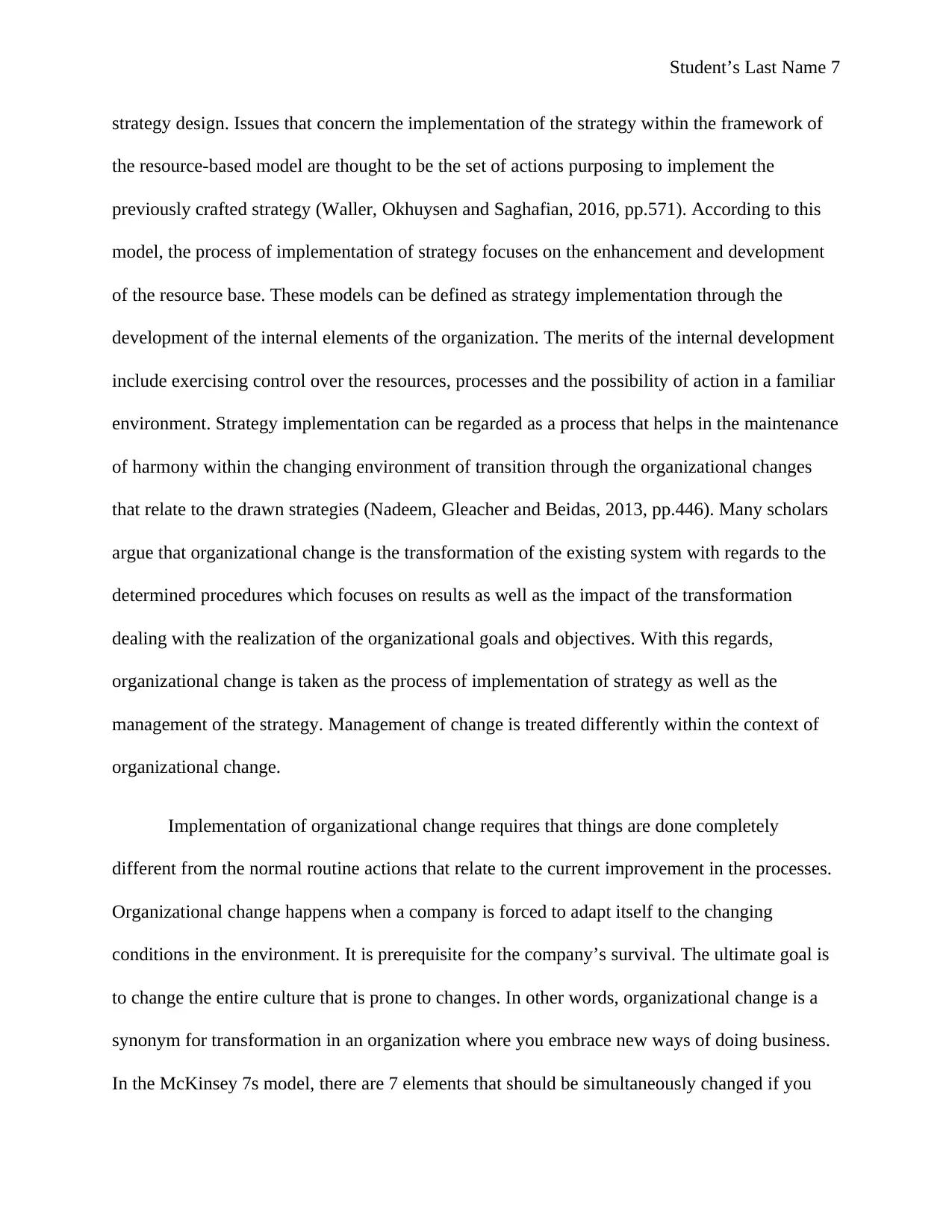
Student’s Last Name 7
strategy design. Issues that concern the implementation of the strategy within the framework of
the resource-based model are thought to be the set of actions purposing to implement the
previously crafted strategy (Waller, Okhuysen and Saghafian, 2016, pp.571). According to this
model, the process of implementation of strategy focuses on the enhancement and development
of the resource base. These models can be defined as strategy implementation through the
development of the internal elements of the organization. The merits of the internal development
include exercising control over the resources, processes and the possibility of action in a familiar
environment. Strategy implementation can be regarded as a process that helps in the maintenance
of harmony within the changing environment of transition through the organizational changes
that relate to the drawn strategies (Nadeem, Gleacher and Beidas, 2013, pp.446). Many scholars
argue that organizational change is the transformation of the existing system with regards to the
determined procedures which focuses on results as well as the impact of the transformation
dealing with the realization of the organizational goals and objectives. With this regards,
organizational change is taken as the process of implementation of strategy as well as the
management of the strategy. Management of change is treated differently within the context of
organizational change.
Implementation of organizational change requires that things are done completely
different from the normal routine actions that relate to the current improvement in the processes.
Organizational change happens when a company is forced to adapt itself to the changing
conditions in the environment. It is prerequisite for the company’s survival. The ultimate goal is
to change the entire culture that is prone to changes. In other words, organizational change is a
synonym for transformation in an organization where you embrace new ways of doing business.
In the McKinsey 7s model, there are 7 elements that should be simultaneously changed if you
strategy design. Issues that concern the implementation of the strategy within the framework of
the resource-based model are thought to be the set of actions purposing to implement the
previously crafted strategy (Waller, Okhuysen and Saghafian, 2016, pp.571). According to this
model, the process of implementation of strategy focuses on the enhancement and development
of the resource base. These models can be defined as strategy implementation through the
development of the internal elements of the organization. The merits of the internal development
include exercising control over the resources, processes and the possibility of action in a familiar
environment. Strategy implementation can be regarded as a process that helps in the maintenance
of harmony within the changing environment of transition through the organizational changes
that relate to the drawn strategies (Nadeem, Gleacher and Beidas, 2013, pp.446). Many scholars
argue that organizational change is the transformation of the existing system with regards to the
determined procedures which focuses on results as well as the impact of the transformation
dealing with the realization of the organizational goals and objectives. With this regards,
organizational change is taken as the process of implementation of strategy as well as the
management of the strategy. Management of change is treated differently within the context of
organizational change.
Implementation of organizational change requires that things are done completely
different from the normal routine actions that relate to the current improvement in the processes.
Organizational change happens when a company is forced to adapt itself to the changing
conditions in the environment. It is prerequisite for the company’s survival. The ultimate goal is
to change the entire culture that is prone to changes. In other words, organizational change is a
synonym for transformation in an organization where you embrace new ways of doing business.
In the McKinsey 7s model, there are 7 elements that should be simultaneously changed if you
Paraphrase This Document
Need a fresh take? Get an instant paraphrase of this document with our AI Paraphraser
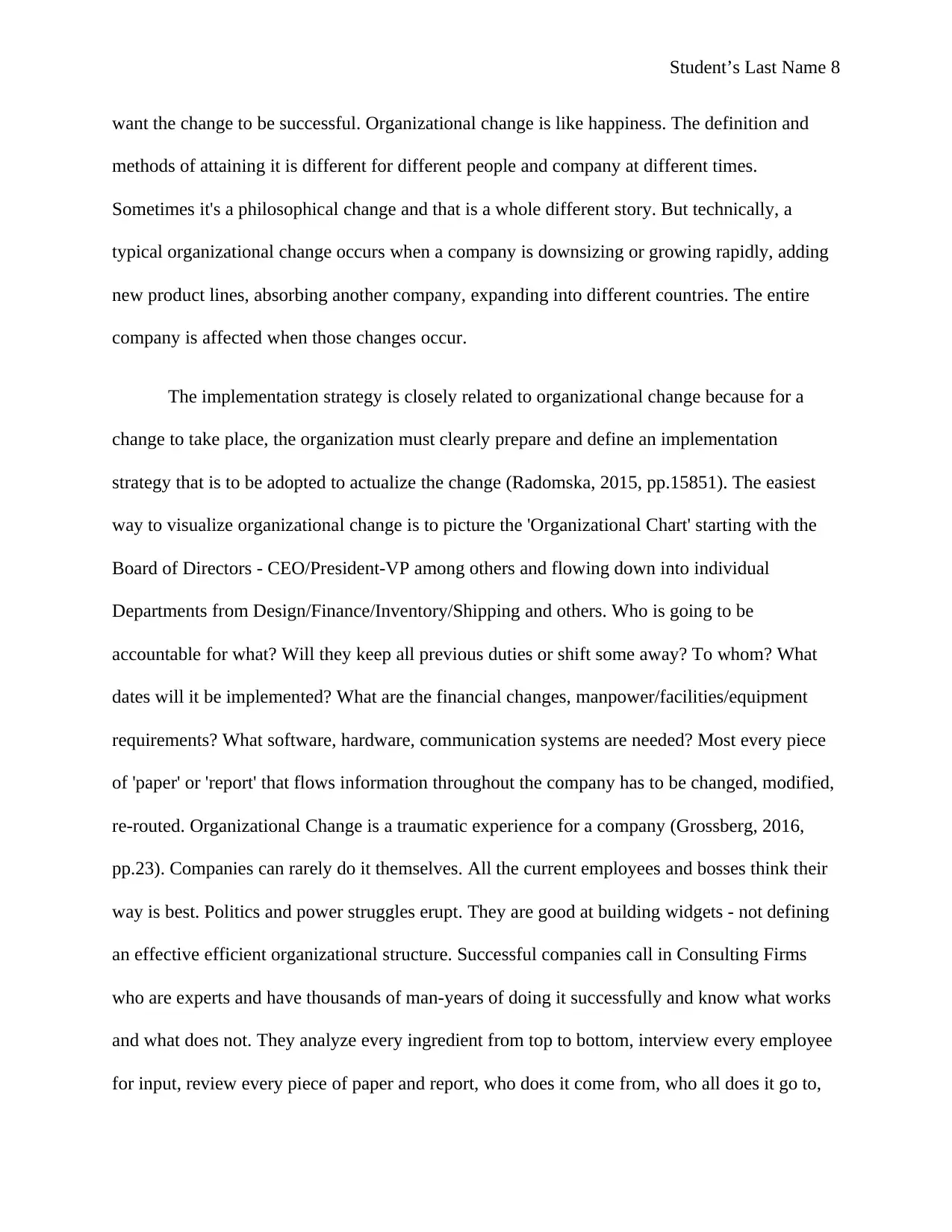
Student’s Last Name 8
want the change to be successful. Organizational change is like happiness. The definition and
methods of attaining it is different for different people and company at different times.
Sometimes it's a philosophical change and that is a whole different story. But technically, a
typical organizational change occurs when a company is downsizing or growing rapidly, adding
new product lines, absorbing another company, expanding into different countries. The entire
company is affected when those changes occur.
The implementation strategy is closely related to organizational change because for a
change to take place, the organization must clearly prepare and define an implementation
strategy that is to be adopted to actualize the change (Radomska, 2015, pp.15851). The easiest
way to visualize organizational change is to picture the 'Organizational Chart' starting with the
Board of Directors - CEO/President-VP among others and flowing down into individual
Departments from Design/Finance/Inventory/Shipping and others. Who is going to be
accountable for what? Will they keep all previous duties or shift some away? To whom? What
dates will it be implemented? What are the financial changes, manpower/facilities/equipment
requirements? What software, hardware, communication systems are needed? Most every piece
of 'paper' or 'report' that flows information throughout the company has to be changed, modified,
re-routed. Organizational Change is a traumatic experience for a company (Grossberg, 2016,
pp.23). Companies can rarely do it themselves. All the current employees and bosses think their
way is best. Politics and power struggles erupt. They are good at building widgets - not defining
an effective efficient organizational structure. Successful companies call in Consulting Firms
who are experts and have thousands of man-years of doing it successfully and know what works
and what does not. They analyze every ingredient from top to bottom, interview every employee
for input, review every piece of paper and report, who does it come from, who all does it go to,
want the change to be successful. Organizational change is like happiness. The definition and
methods of attaining it is different for different people and company at different times.
Sometimes it's a philosophical change and that is a whole different story. But technically, a
typical organizational change occurs when a company is downsizing or growing rapidly, adding
new product lines, absorbing another company, expanding into different countries. The entire
company is affected when those changes occur.
The implementation strategy is closely related to organizational change because for a
change to take place, the organization must clearly prepare and define an implementation
strategy that is to be adopted to actualize the change (Radomska, 2015, pp.15851). The easiest
way to visualize organizational change is to picture the 'Organizational Chart' starting with the
Board of Directors - CEO/President-VP among others and flowing down into individual
Departments from Design/Finance/Inventory/Shipping and others. Who is going to be
accountable for what? Will they keep all previous duties or shift some away? To whom? What
dates will it be implemented? What are the financial changes, manpower/facilities/equipment
requirements? What software, hardware, communication systems are needed? Most every piece
of 'paper' or 'report' that flows information throughout the company has to be changed, modified,
re-routed. Organizational Change is a traumatic experience for a company (Grossberg, 2016,
pp.23). Companies can rarely do it themselves. All the current employees and bosses think their
way is best. Politics and power struggles erupt. They are good at building widgets - not defining
an effective efficient organizational structure. Successful companies call in Consulting Firms
who are experts and have thousands of man-years of doing it successfully and know what works
and what does not. They analyze every ingredient from top to bottom, interview every employee
for input, review every piece of paper and report, who does it come from, who all does it go to,
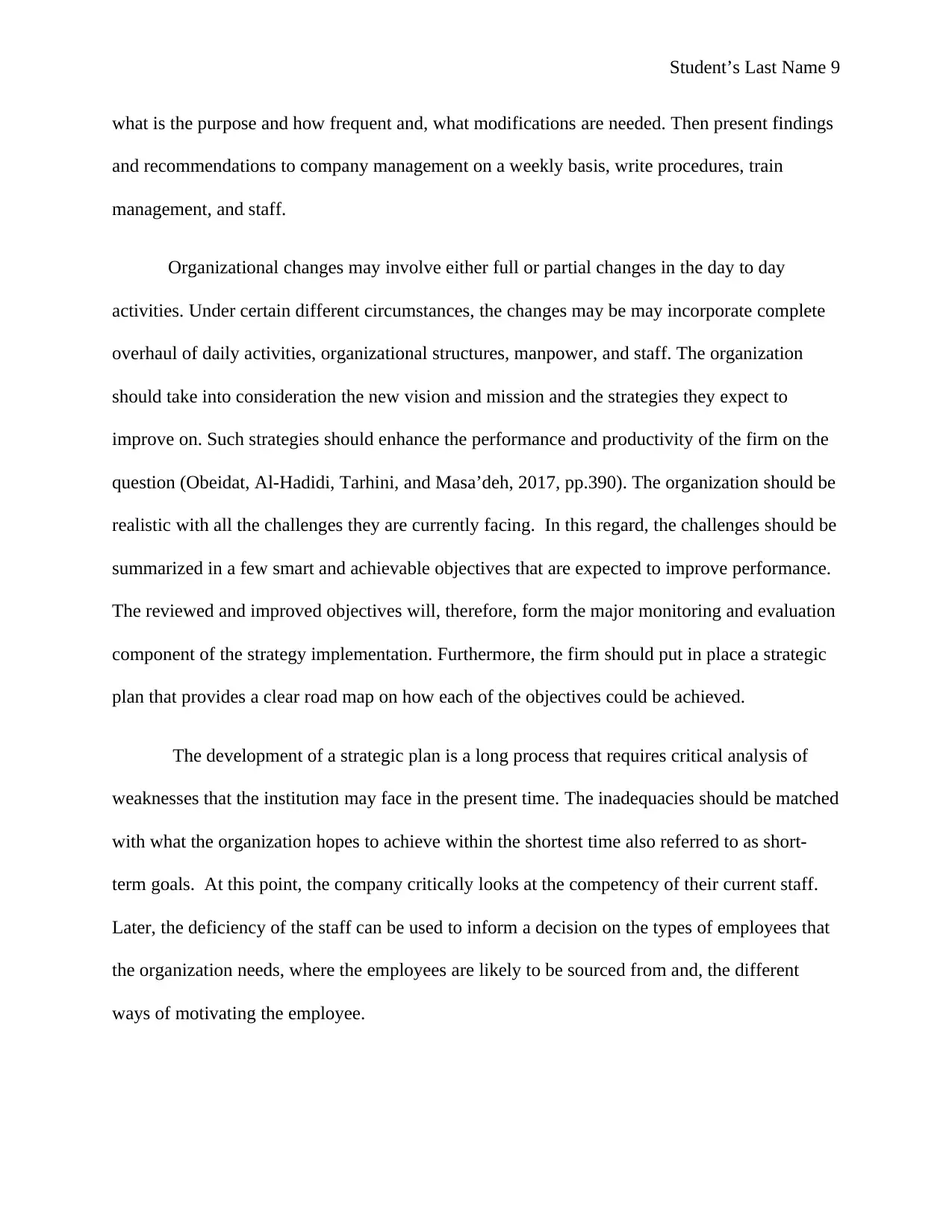
Student’s Last Name 9
what is the purpose and how frequent and, what modifications are needed. Then present findings
and recommendations to company management on a weekly basis, write procedures, train
management, and staff.
Organizational changes may involve either full or partial changes in the day to day
activities. Under certain different circumstances, the changes may be may incorporate complete
overhaul of daily activities, organizational structures, manpower, and staff. The organization
should take into consideration the new vision and mission and the strategies they expect to
improve on. Such strategies should enhance the performance and productivity of the firm on the
question (Obeidat, Al-Hadidi, Tarhini, and Masa’deh, 2017, pp.390). The organization should be
realistic with all the challenges they are currently facing. In this regard, the challenges should be
summarized in a few smart and achievable objectives that are expected to improve performance.
The reviewed and improved objectives will, therefore, form the major monitoring and evaluation
component of the strategy implementation. Furthermore, the firm should put in place a strategic
plan that provides a clear road map on how each of the objectives could be achieved.
The development of a strategic plan is a long process that requires critical analysis of
weaknesses that the institution may face in the present time. The inadequacies should be matched
with what the organization hopes to achieve within the shortest time also referred to as short-
term goals. At this point, the company critically looks at the competency of their current staff.
Later, the deficiency of the staff can be used to inform a decision on the types of employees that
the organization needs, where the employees are likely to be sourced from and, the different
ways of motivating the employee.
what is the purpose and how frequent and, what modifications are needed. Then present findings
and recommendations to company management on a weekly basis, write procedures, train
management, and staff.
Organizational changes may involve either full or partial changes in the day to day
activities. Under certain different circumstances, the changes may be may incorporate complete
overhaul of daily activities, organizational structures, manpower, and staff. The organization
should take into consideration the new vision and mission and the strategies they expect to
improve on. Such strategies should enhance the performance and productivity of the firm on the
question (Obeidat, Al-Hadidi, Tarhini, and Masa’deh, 2017, pp.390). The organization should be
realistic with all the challenges they are currently facing. In this regard, the challenges should be
summarized in a few smart and achievable objectives that are expected to improve performance.
The reviewed and improved objectives will, therefore, form the major monitoring and evaluation
component of the strategy implementation. Furthermore, the firm should put in place a strategic
plan that provides a clear road map on how each of the objectives could be achieved.
The development of a strategic plan is a long process that requires critical analysis of
weaknesses that the institution may face in the present time. The inadequacies should be matched
with what the organization hopes to achieve within the shortest time also referred to as short-
term goals. At this point, the company critically looks at the competency of their current staff.
Later, the deficiency of the staff can be used to inform a decision on the types of employees that
the organization needs, where the employees are likely to be sourced from and, the different
ways of motivating the employee.
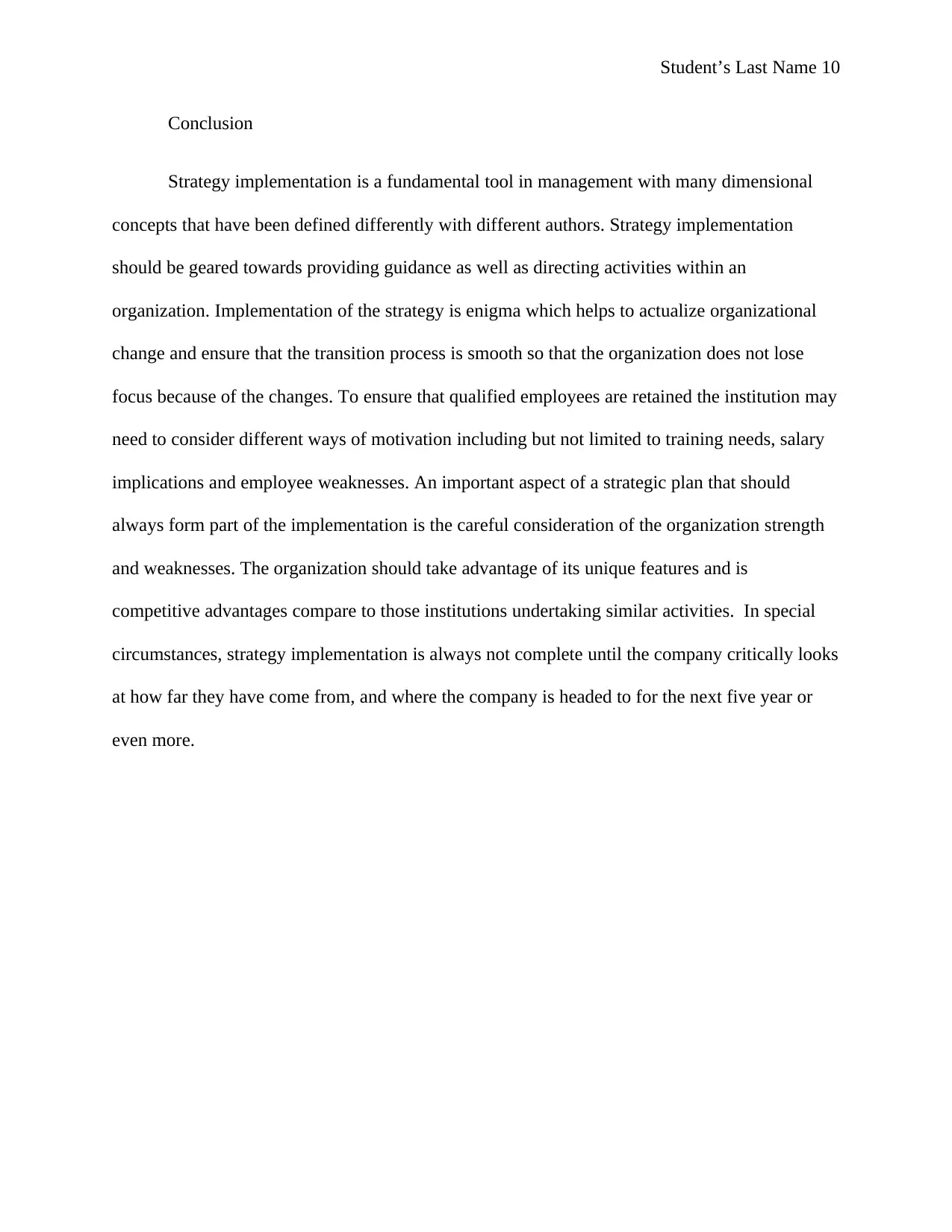
Student’s Last Name 10
Conclusion
Strategy implementation is a fundamental tool in management with many dimensional
concepts that have been defined differently with different authors. Strategy implementation
should be geared towards providing guidance as well as directing activities within an
organization. Implementation of the strategy is enigma which helps to actualize organizational
change and ensure that the transition process is smooth so that the organization does not lose
focus because of the changes. To ensure that qualified employees are retained the institution may
need to consider different ways of motivation including but not limited to training needs, salary
implications and employee weaknesses. An important aspect of a strategic plan that should
always form part of the implementation is the careful consideration of the organization strength
and weaknesses. The organization should take advantage of its unique features and is
competitive advantages compare to those institutions undertaking similar activities. In special
circumstances, strategy implementation is always not complete until the company critically looks
at how far they have come from, and where the company is headed to for the next five year or
even more.
Conclusion
Strategy implementation is a fundamental tool in management with many dimensional
concepts that have been defined differently with different authors. Strategy implementation
should be geared towards providing guidance as well as directing activities within an
organization. Implementation of the strategy is enigma which helps to actualize organizational
change and ensure that the transition process is smooth so that the organization does not lose
focus because of the changes. To ensure that qualified employees are retained the institution may
need to consider different ways of motivation including but not limited to training needs, salary
implications and employee weaknesses. An important aspect of a strategic plan that should
always form part of the implementation is the careful consideration of the organization strength
and weaknesses. The organization should take advantage of its unique features and is
competitive advantages compare to those institutions undertaking similar activities. In special
circumstances, strategy implementation is always not complete until the company critically looks
at how far they have come from, and where the company is headed to for the next five year or
even more.
Secure Best Marks with AI Grader
Need help grading? Try our AI Grader for instant feedback on your assignments.

Student’s Last Name 11
Bibliography
Bamberger, P.A., Biron, M. and Meshoulam, I., 2014. Human resource strategy: Formulation,
implementation, and impact. Routledge.
Bisbe, J. and Barrubés, J., 2012. The balanced scorecard as a management tool for assessing and
monitoring strategy implementation in health care organizations. Revista Española de
Cardiología (English Edition), 65(10), pp.919-927
Borges, A., Abreu, A., Dias, C., Saavedra, M., Borges, F. and Simões, M., 2016. New
perspectives on the use of phytochemicals as an emergent strategy to control bacterial infections
including biofilms. Molecules, 21(7), p.877.
Carlopio, J. and Harvey, M., 2012. The development of a social psychological model of strategy
implementation. development, 9, pp.1-2012.
Chen, J.E., Pan, S.L. and Ouyang, T.H., 2014. Routine reconfiguration in traditional
companies’e-commerce strategy implementation: A trajectory perspective. Information &
Management, 51(2), pp.270-282.
Greer, C.R., Lusch, R.F. and Hitt, M.A., 2017. A service perspective for human capital
resources: A critical base for strategy implementation. Academy of Management
Perspectives, 31(2), pp.137-158.
Grossberg, K.A., 2016. The new marketing solutions that will drive strategy
implementation. Strategy & leadership, 44(3), pp.20-26.
Bibliography
Bamberger, P.A., Biron, M. and Meshoulam, I., 2014. Human resource strategy: Formulation,
implementation, and impact. Routledge.
Bisbe, J. and Barrubés, J., 2012. The balanced scorecard as a management tool for assessing and
monitoring strategy implementation in health care organizations. Revista Española de
Cardiología (English Edition), 65(10), pp.919-927
Borges, A., Abreu, A., Dias, C., Saavedra, M., Borges, F. and Simões, M., 2016. New
perspectives on the use of phytochemicals as an emergent strategy to control bacterial infections
including biofilms. Molecules, 21(7), p.877.
Carlopio, J. and Harvey, M., 2012. The development of a social psychological model of strategy
implementation. development, 9, pp.1-2012.
Chen, J.E., Pan, S.L. and Ouyang, T.H., 2014. Routine reconfiguration in traditional
companies’e-commerce strategy implementation: A trajectory perspective. Information &
Management, 51(2), pp.270-282.
Greer, C.R., Lusch, R.F. and Hitt, M.A., 2017. A service perspective for human capital
resources: A critical base for strategy implementation. Academy of Management
Perspectives, 31(2), pp.137-158.
Grossberg, K.A., 2016. The new marketing solutions that will drive strategy
implementation. Strategy & leadership, 44(3), pp.20-26.
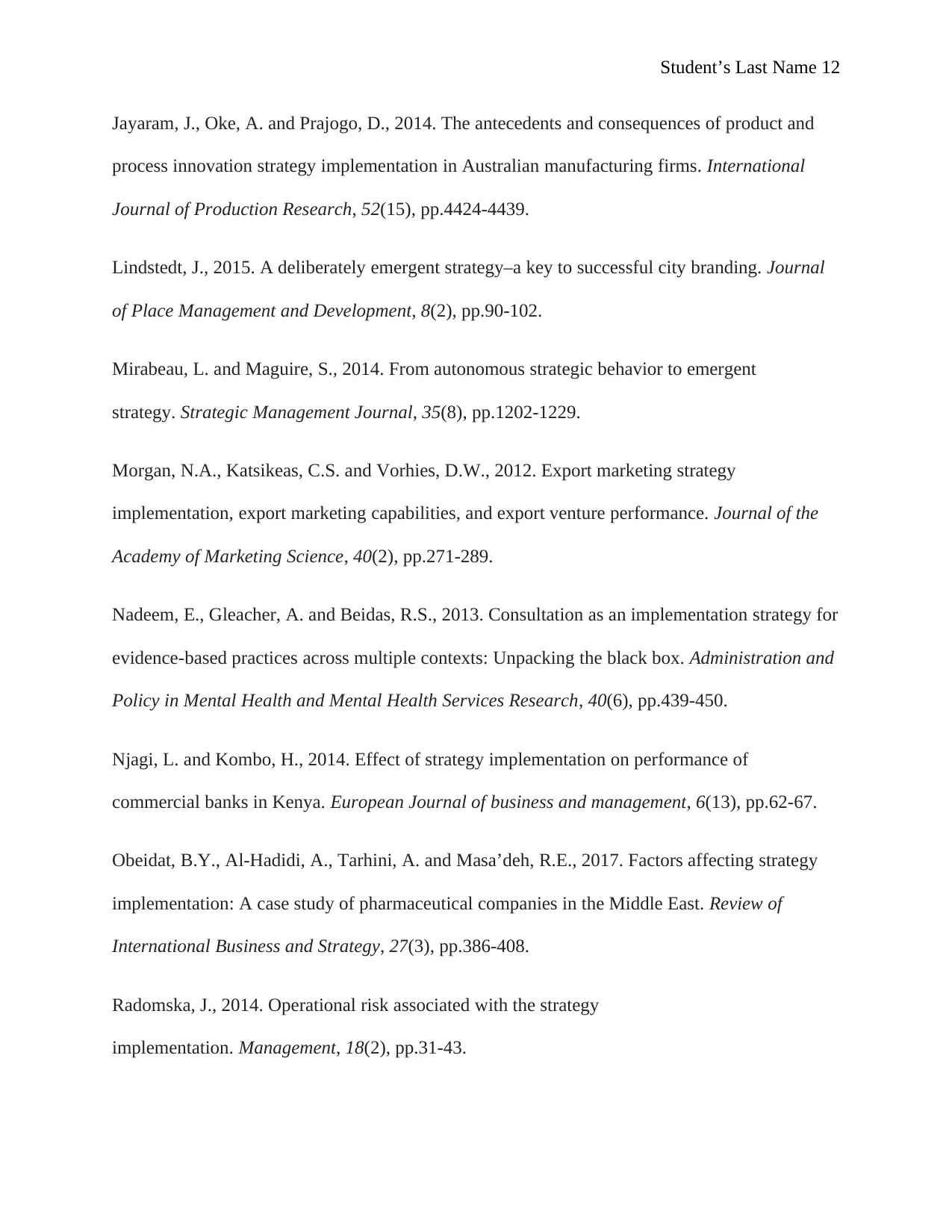
Student’s Last Name 12
Jayaram, J., Oke, A. and Prajogo, D., 2014. The antecedents and consequences of product and
process innovation strategy implementation in Australian manufacturing firms. International
Journal of Production Research, 52(15), pp.4424-4439.
Lindstedt, J., 2015. A deliberately emergent strategy–a key to successful city branding. Journal
of Place Management and Development, 8(2), pp.90-102.
Mirabeau, L. and Maguire, S., 2014. From autonomous strategic behavior to emergent
strategy. Strategic Management Journal, 35(8), pp.1202-1229.
Morgan, N.A., Katsikeas, C.S. and Vorhies, D.W., 2012. Export marketing strategy
implementation, export marketing capabilities, and export venture performance. Journal of the
Academy of Marketing Science, 40(2), pp.271-289.
Nadeem, E., Gleacher, A. and Beidas, R.S., 2013. Consultation as an implementation strategy for
evidence-based practices across multiple contexts: Unpacking the black box. Administration and
Policy in Mental Health and Mental Health Services Research, 40(6), pp.439-450.
Njagi, L. and Kombo, H., 2014. Effect of strategy implementation on performance of
commercial banks in Kenya. European Journal of business and management, 6(13), pp.62-67.
Obeidat, B.Y., Al-Hadidi, A., Tarhini, A. and Masa’deh, R.E., 2017. Factors affecting strategy
implementation: A case study of pharmaceutical companies in the Middle East. Review of
International Business and Strategy, 27(3), pp.386-408.
Radomska, J., 2014. Operational risk associated with the strategy
implementation. Management, 18(2), pp.31-43.
Jayaram, J., Oke, A. and Prajogo, D., 2014. The antecedents and consequences of product and
process innovation strategy implementation in Australian manufacturing firms. International
Journal of Production Research, 52(15), pp.4424-4439.
Lindstedt, J., 2015. A deliberately emergent strategy–a key to successful city branding. Journal
of Place Management and Development, 8(2), pp.90-102.
Mirabeau, L. and Maguire, S., 2014. From autonomous strategic behavior to emergent
strategy. Strategic Management Journal, 35(8), pp.1202-1229.
Morgan, N.A., Katsikeas, C.S. and Vorhies, D.W., 2012. Export marketing strategy
implementation, export marketing capabilities, and export venture performance. Journal of the
Academy of Marketing Science, 40(2), pp.271-289.
Nadeem, E., Gleacher, A. and Beidas, R.S., 2013. Consultation as an implementation strategy for
evidence-based practices across multiple contexts: Unpacking the black box. Administration and
Policy in Mental Health and Mental Health Services Research, 40(6), pp.439-450.
Njagi, L. and Kombo, H., 2014. Effect of strategy implementation on performance of
commercial banks in Kenya. European Journal of business and management, 6(13), pp.62-67.
Obeidat, B.Y., Al-Hadidi, A., Tarhini, A. and Masa’deh, R.E., 2017. Factors affecting strategy
implementation: A case study of pharmaceutical companies in the Middle East. Review of
International Business and Strategy, 27(3), pp.386-408.
Radomska, J., 2014. Operational risk associated with the strategy
implementation. Management, 18(2), pp.31-43.
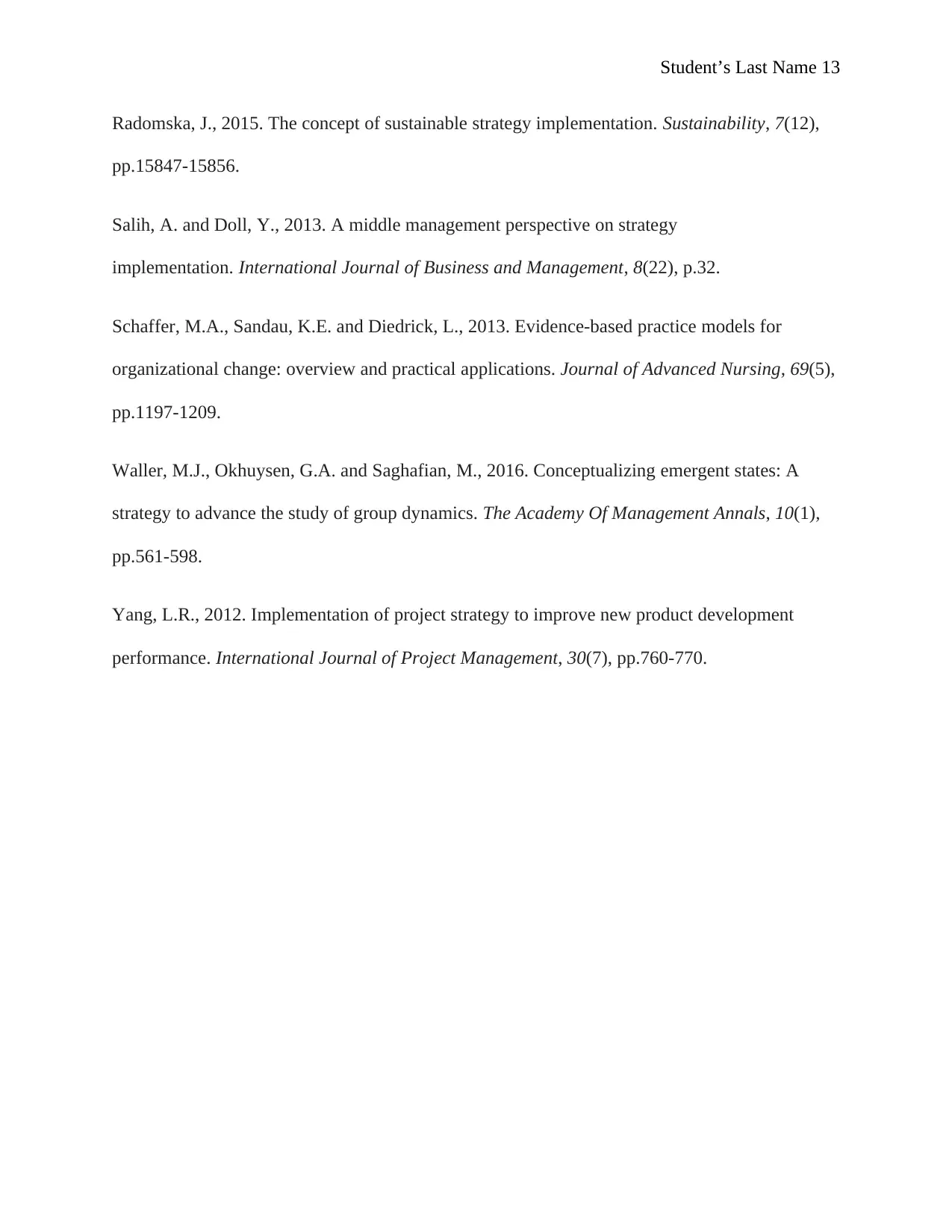
Student’s Last Name 13
Radomska, J., 2015. The concept of sustainable strategy implementation. Sustainability, 7(12),
pp.15847-15856.
Salih, A. and Doll, Y., 2013. A middle management perspective on strategy
implementation. International Journal of Business and Management, 8(22), p.32.
Schaffer, M.A., Sandau, K.E. and Diedrick, L., 2013. Evidence‐based practice models for
organizational change: overview and practical applications. Journal of Advanced Nursing, 69(5),
pp.1197-1209.
Waller, M.J., Okhuysen, G.A. and Saghafian, M., 2016. Conceptualizing emergent states: A
strategy to advance the study of group dynamics. The Academy Of Management Annals, 10(1),
pp.561-598.
Yang, L.R., 2012. Implementation of project strategy to improve new product development
performance. International Journal of Project Management, 30(7), pp.760-770.
Radomska, J., 2015. The concept of sustainable strategy implementation. Sustainability, 7(12),
pp.15847-15856.
Salih, A. and Doll, Y., 2013. A middle management perspective on strategy
implementation. International Journal of Business and Management, 8(22), p.32.
Schaffer, M.A., Sandau, K.E. and Diedrick, L., 2013. Evidence‐based practice models for
organizational change: overview and practical applications. Journal of Advanced Nursing, 69(5),
pp.1197-1209.
Waller, M.J., Okhuysen, G.A. and Saghafian, M., 2016. Conceptualizing emergent states: A
strategy to advance the study of group dynamics. The Academy Of Management Annals, 10(1),
pp.561-598.
Yang, L.R., 2012. Implementation of project strategy to improve new product development
performance. International Journal of Project Management, 30(7), pp.760-770.
1 out of 13
Related Documents
Your All-in-One AI-Powered Toolkit for Academic Success.
+13062052269
info@desklib.com
Available 24*7 on WhatsApp / Email
![[object Object]](/_next/static/media/star-bottom.7253800d.svg)
Unlock your academic potential
© 2024 | Zucol Services PVT LTD | All rights reserved.





